

Well, "what could go wrong?" is "Your origami skills suck." There were lots of programs where we were folding paper into specific shapes, mathematical or otherwise, and no matter how hard I try to fold things exactly where they're supposed to go, I'm just off enough that it becomes a problem later on. Some programs have fault tolerance for people who can't quite get the hang of folding, but some of them don't, and the best I could do was try anyway, even though I knew that it was going to come out lopsided or that it would fall apart the instant I looked at it with the expectation that it was going to hold together. That, and it can be really hard to demonstrate some trickier folds while holding it up to the camera for others to see. As useful as it would have been to use a two-camera setup, I think my home internet would have simply laughed at me if I had tried. (It did plenty of falling over and disconnecting or freezing during the program all the same, such that I am still pretty grateful to have a phone that I can use the data plan for a Wi-Fi connection so that I have a stable connection to do video calls and programming on.)
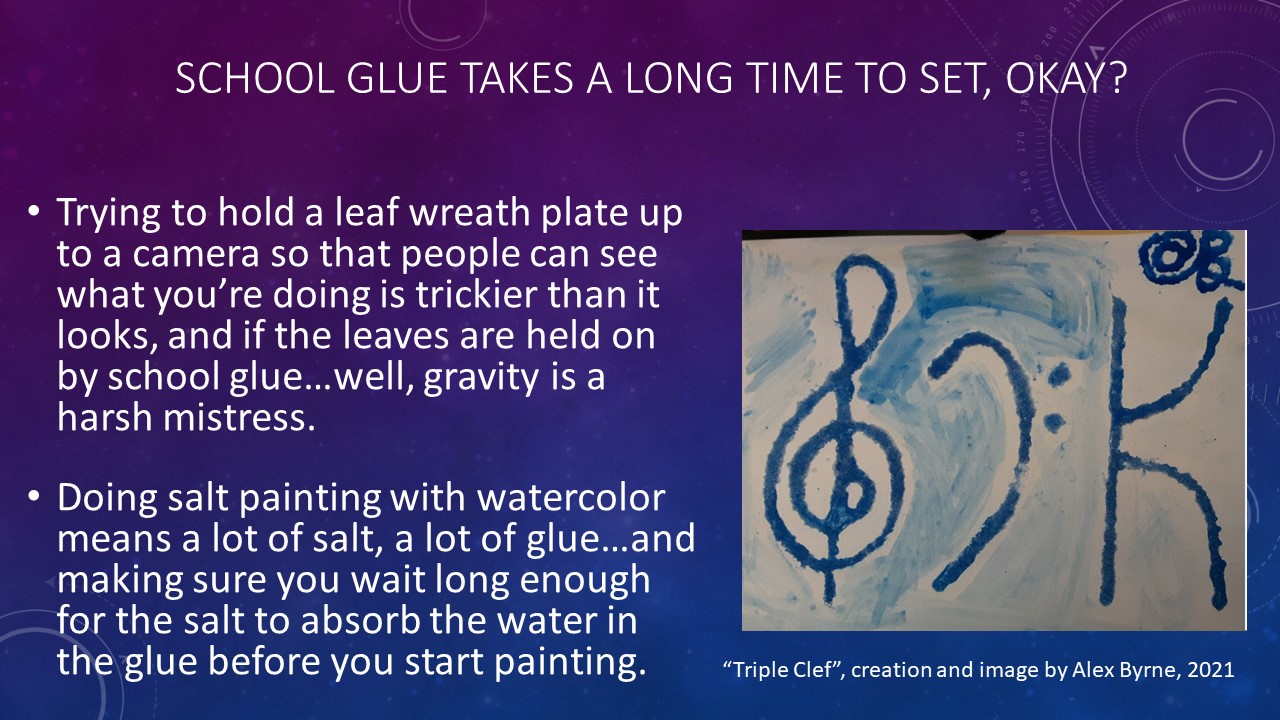
Doing things with glue is just asking for a critical failure, especially when you try to hold something up to the camera to show how it should look and the glue's not dry enough to support that idea. Gravity is a harsh mistress, and exacting in her demands. I had a few times where my leaf wreath would just slide off the plate, or I had to be careful about the angle of my salt painting, because the glue would just drop right down onto something else if I wasn't careful, or even that I needed to wait for the salt to absorb the water in the glue before applying pigment, because, well, the colors would run otherwise because of too much water. I learned so much about what you can and can't use school glue to hold together. Mostly by trying it and finding out that it didn't work like that, or that I needed to wait longer before manipulation.
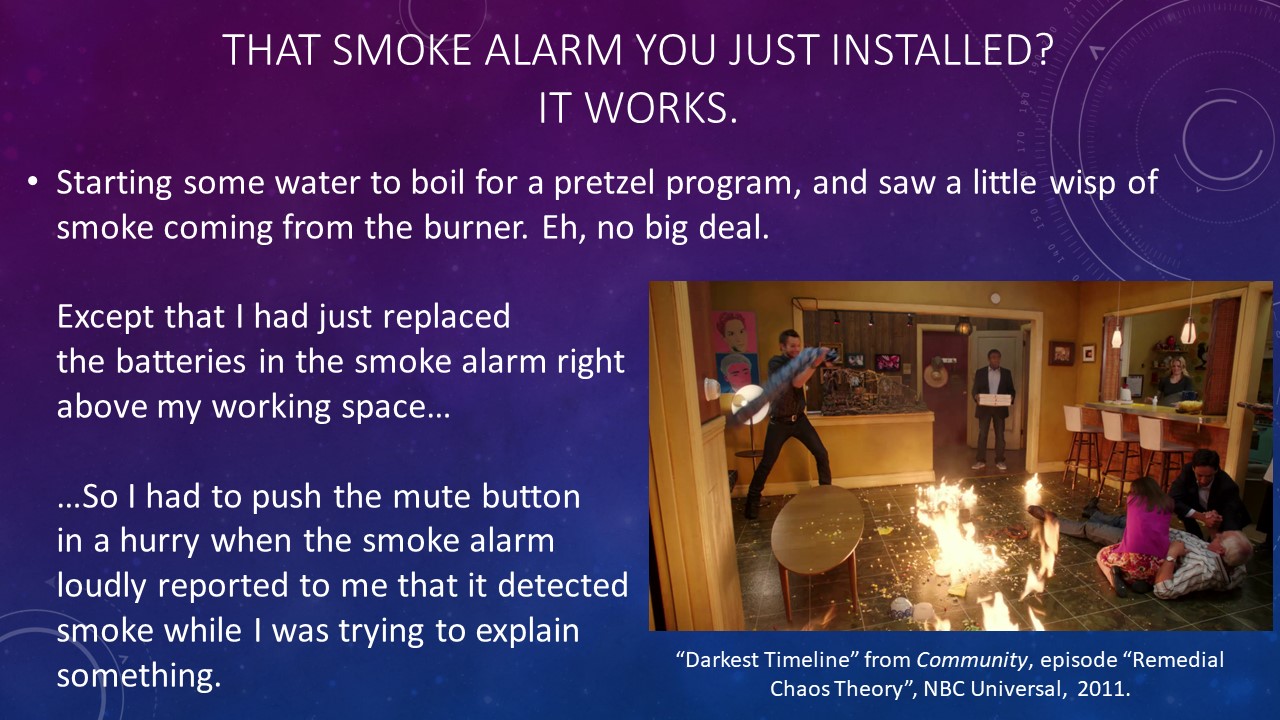
One of the really nice things about the shift to virtual, though, is that I got to do kitchen programs and cooking things, since I had my tools, my oven, and my cooktops available, rather than having to try and haul of that in for a program and then try to supervise lots of small ones at hot burners and the like.
It also turns out that replacing the smoke detectors with something a little more new means they're also a little more sensitive, and that wisp of smoke from a burner burning something off resulted in a very loud alarm going off in the middle of a program. We got it under control and finished things out without a problem, but I was still the only person who had their smoke alarm go off during the program the whole time we did it. I had a pretty good facepalm about that after the program. Good thing I had something delicious to eat while I had a whole embarrassment about it.
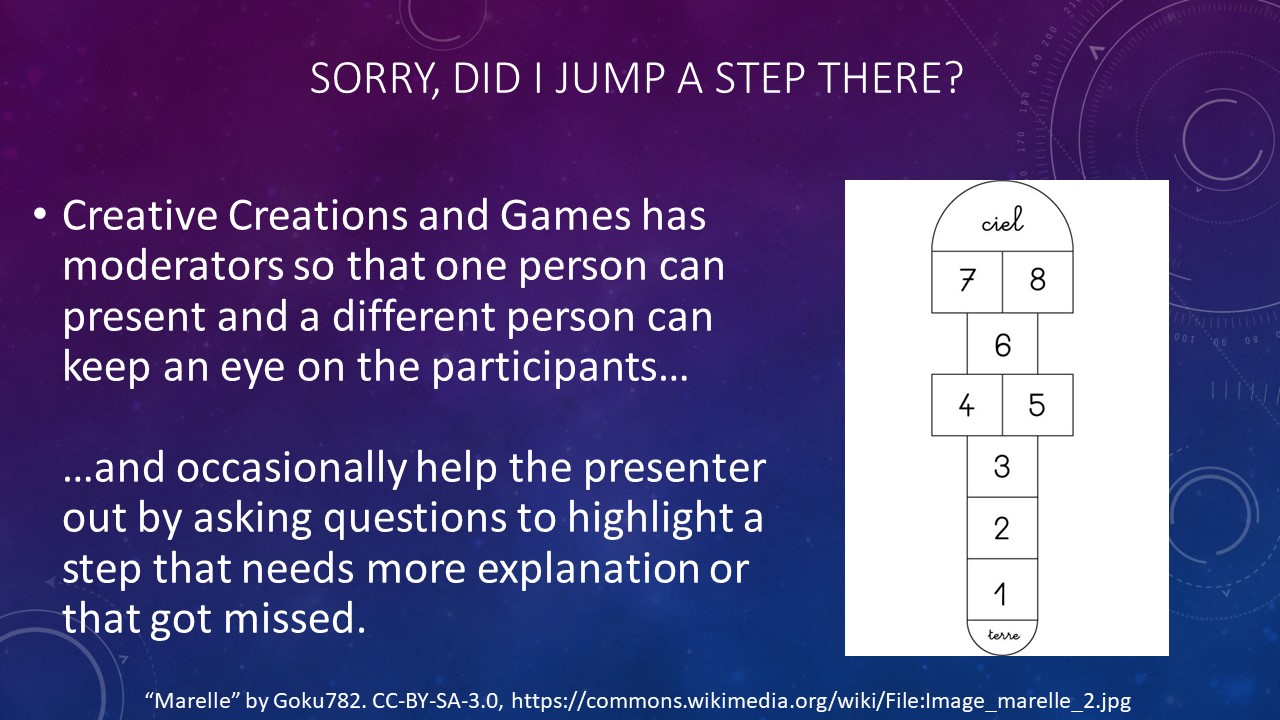
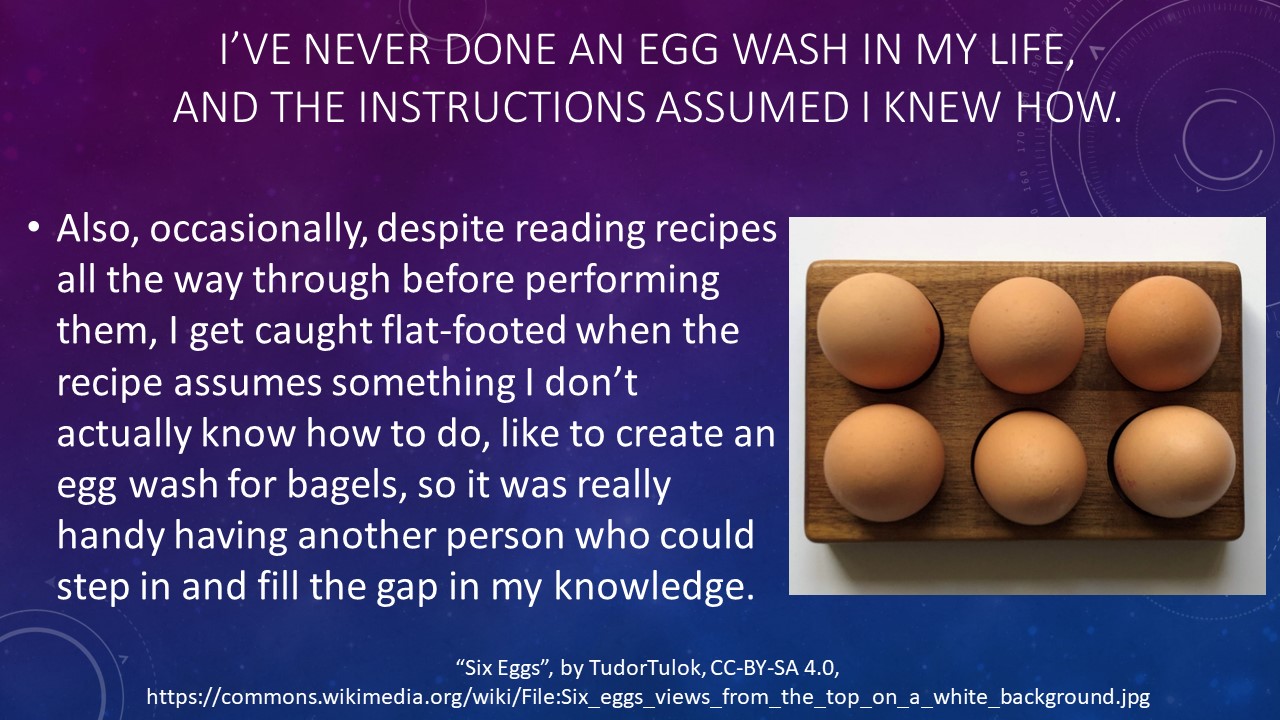
And then there are the times where you're very glad to have someone else presenting the program with you. Because I had more than a few times where I skipped over a step that I needed to articulate or explain, or I did a motion that I hadn't explained yet, or hadn't fully explained yet, so that the participants could follow along or do the thing the way they were going to.
There was also one memorable case, while making baked goods, where the recipe, having said that we needed an egg for something, gave the instruction "Give the baked goods an egg wash." It did not explain what an egg wash was, nor how to prepare it and apply it. I felt a little bit like a Baking Show contestant in their technical challenge staring at an instruction that says something like "Make a Victoria Sponge." Luckily for me, my co-presenter did know what an egg wash was and how to do it, but that'll teacch me not to read the recipes all the way through before attempting to use them for a program, right? (They turned out delicious.)
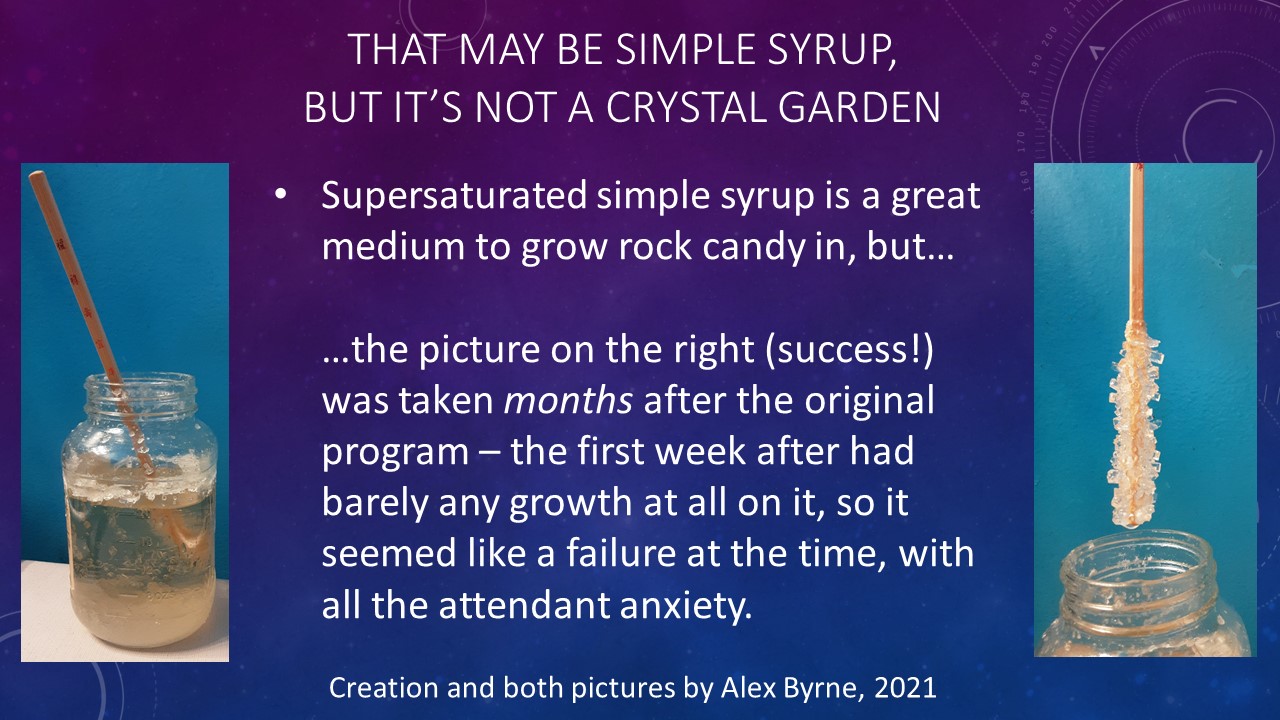
One fo the programs we did was to create some supersaturated syrup, then dust a stick with some sugar and let it grow rock candy crystals.
It didn't work in the program time. It didn't really work all that well in a day or two after, but there was at least the promise of progress. In truth, it took months of letting the crystals grow before anything that resembled rock candy appeared on the skewers that I'd set into the solution. So the program was a success, but it wasn't on the timescale I was trying for in those programs, and I was disappointed that it hadn't gone according to plan on my timescale. (The candy was delicious after I had given it enough time to grow and mature all the same. Some things are, indeed, worth waiting for.)
So, there was a lot of things going wrong and failure while I was doing this programming sequence. And not a whole lot I could do about it other than push forward and keep trying, or see what I could salvage of the thing, or wait out the problem and then try again. And all of these scenarios, except the folding ones, ultimately resulted in successes, just successes with setbacks. The whole time was a good example of what the Science Librarian had been trying to help us understand about doing Mobile Maker Programs and the acceptability of failure or weirdness happening as part of the program.
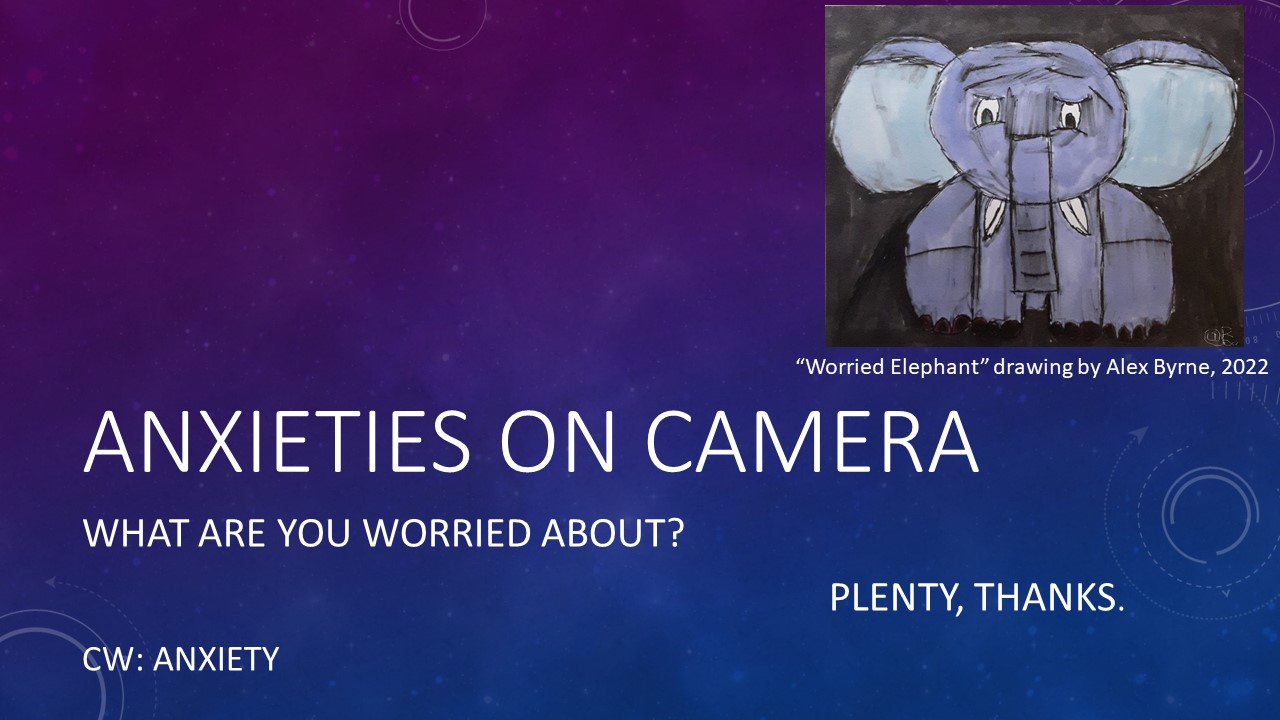
In addition to the fear of failure in front of others, I had a fair amount of anxiety around the possibility of having to create something without a set of detailed instructions, or a template to use, or having all of the difficult work done for me so that all I needed was to asssemble the thing (or cut out a hundred thousand of them for all the attendees to assemble.) Especially around artistic applications or crafty things, things that I had mostly believed I lacked skill at, because they didn't look like the polished high quality things that everyone else created, seemingly without effort.
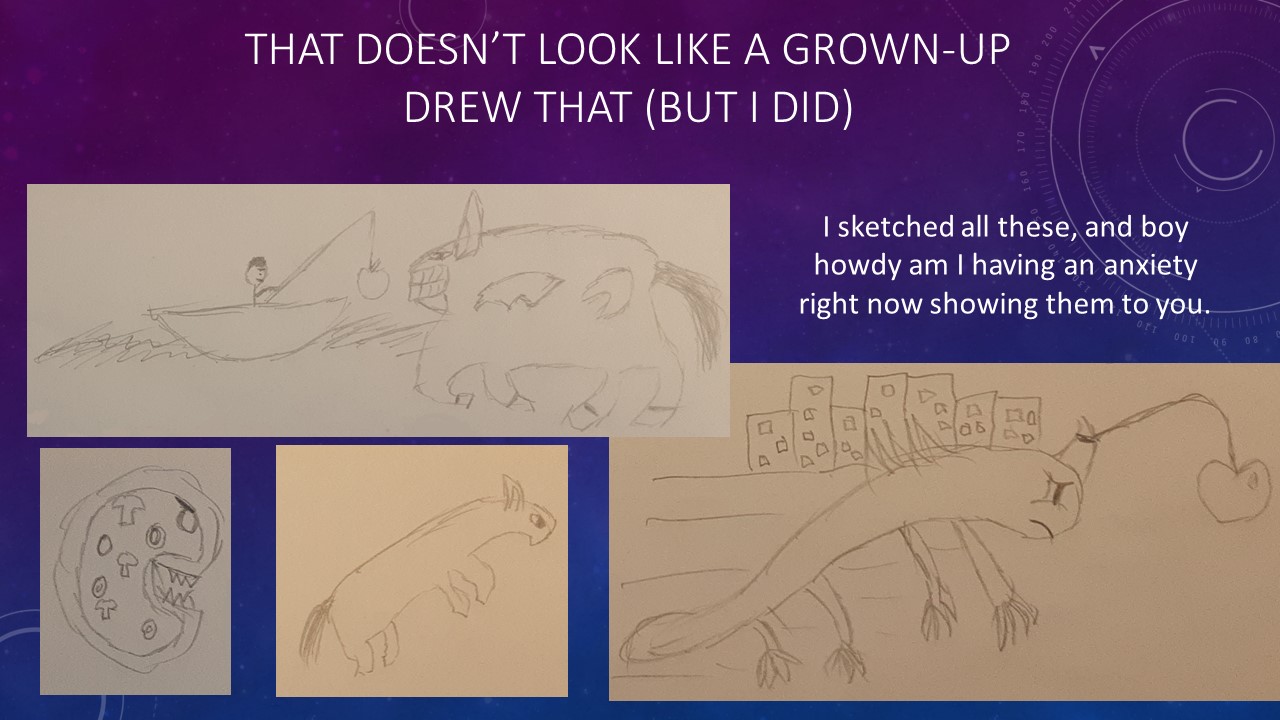
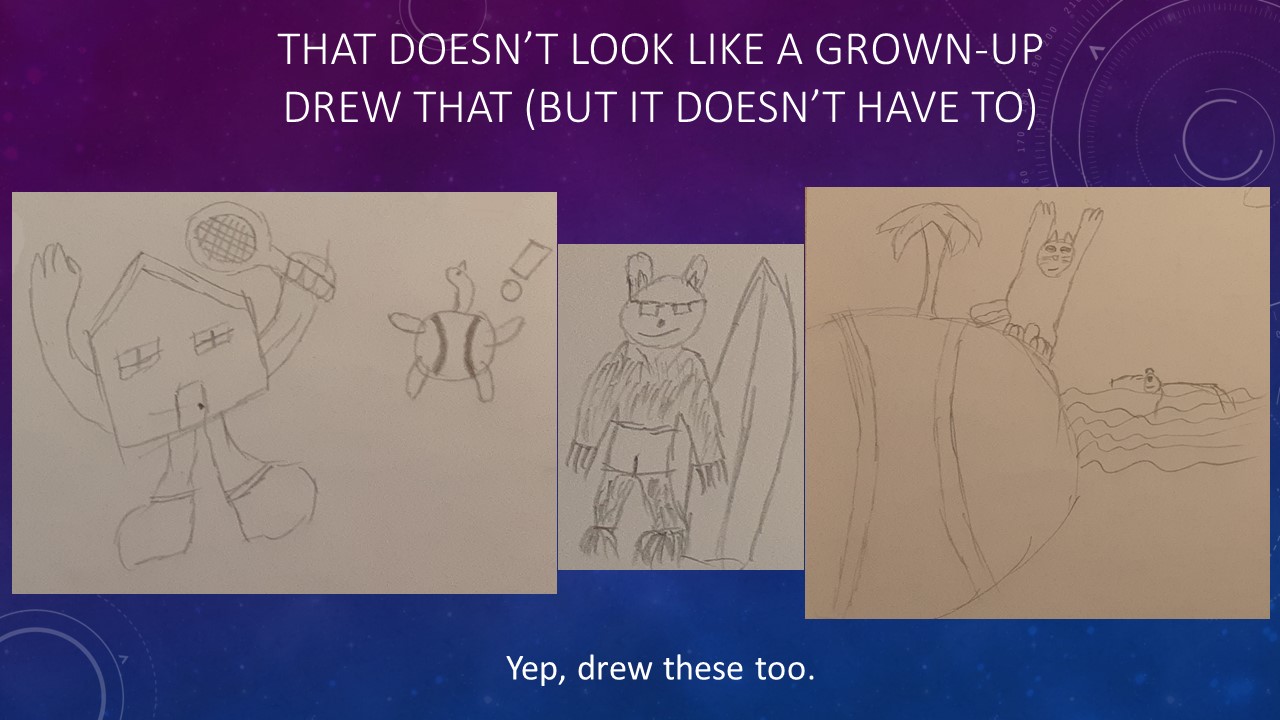
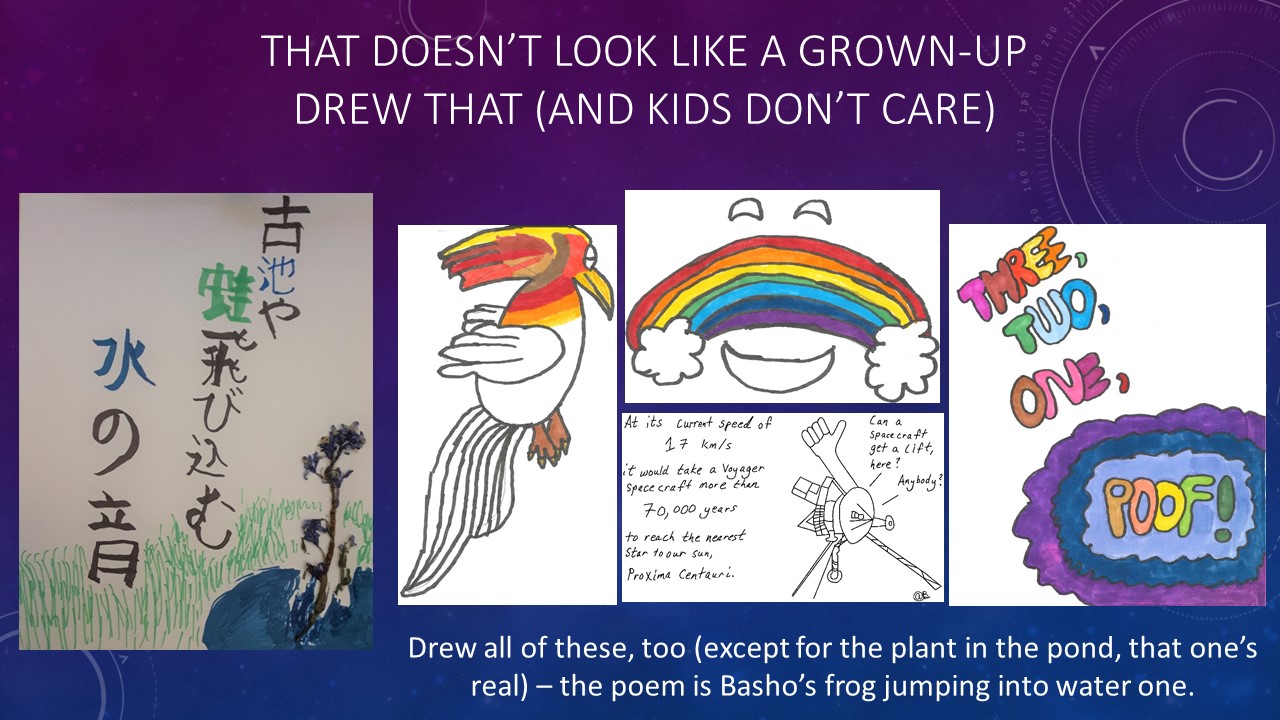
We did a lot of drawing in those programs, and I never looked at my drawings and went "This looks good." I always worried that the attendees (who are, at this point, on average, one fourth to one third of my current age) were going to point and laugh at it as weird or strange or not very well done. They didn't, but just because it hasn't happened before doesn't mean it won't happen the next rime, right? (It did not happen at any point during any of the programs.) Even putting this out for others to see is always going to cause a low-grade anxiety, because someone might look at it and judge me, and they might judge me in such a way that they tell me they're judging me. We'll get to why other people's opinions of me are such an outsize influence in a little bit.
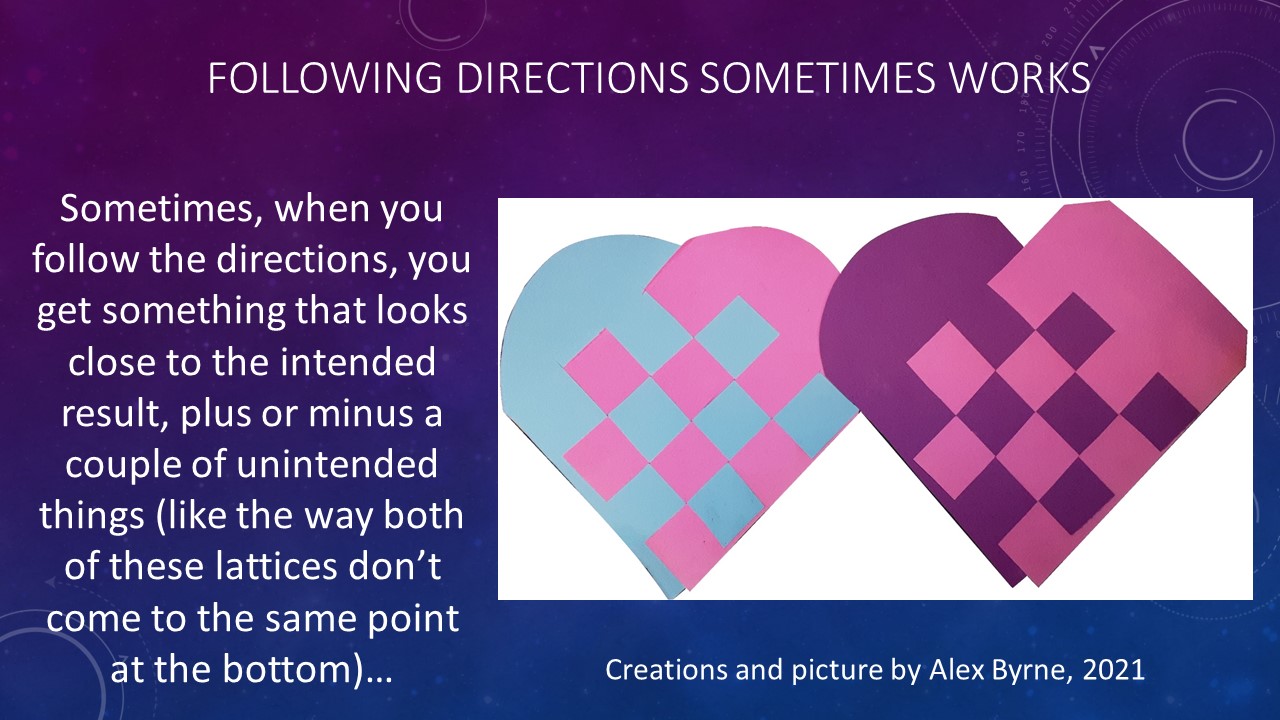
Some of the programs that we had started with a set of instructions to create something, like weaving two sheets of paper together to create a two-toned heart. Following the directions worked, for the most part, even if doing it meant that the point at the bottom of the heart on both papers never really lined up with each other like I wanted them to. (They weren't going to - the friction and displacement of the paper guaranteed it.)
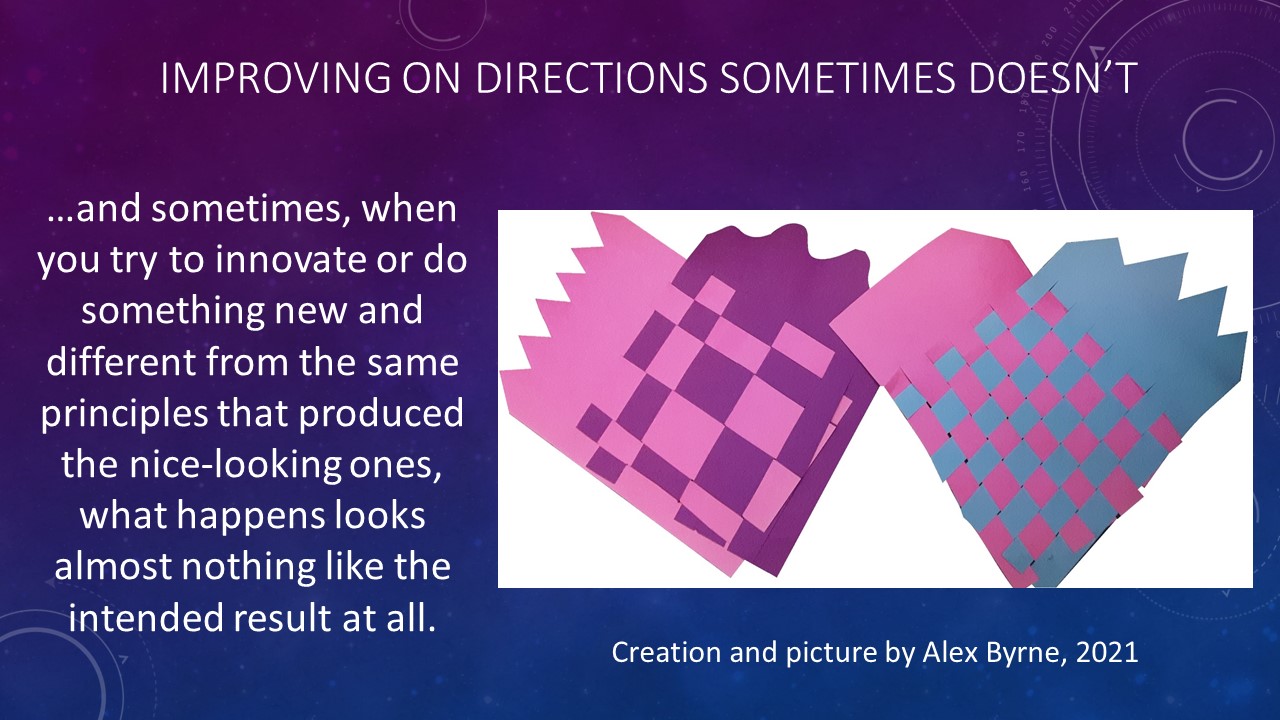
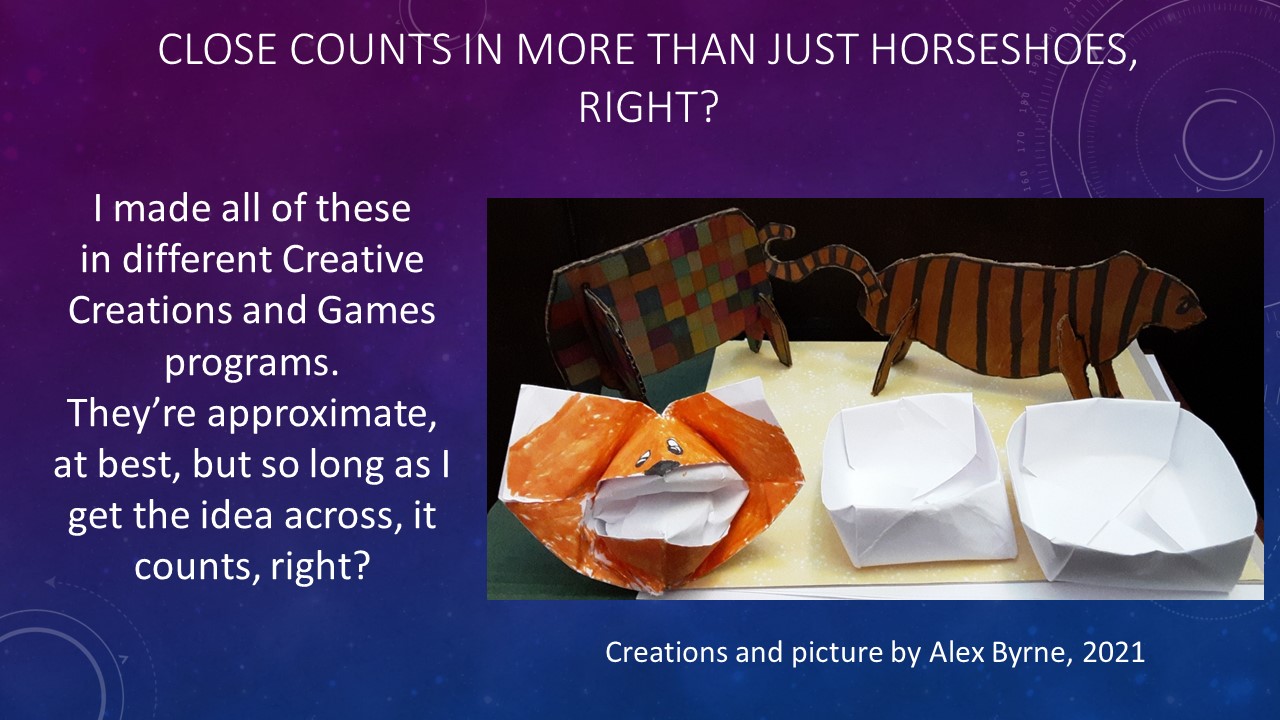
Once we had created an example according to the directions, then the rest of the program was spent in experimenting and changing the design to see what modifications would work and what ones would not. Mine turned out mostly on the "not" side. Or the "ish" side, which, by the way, if you have it in your library, "Ish" by Peter H. Reynolds is a fabulous book about embracing the inexactness of art of style and skilland learning about how to see some things from the perspective of the audience, instead of the artist. Hightly recommended. A lot of my results are the kinds of things where there are enough cues to get you to think that what I've created is something - a tiget by the stripes and the tail, a fox by the coloration and the approximate shape, a box that theoretically fits together, or would fit together more easily if it were a bit better folded.
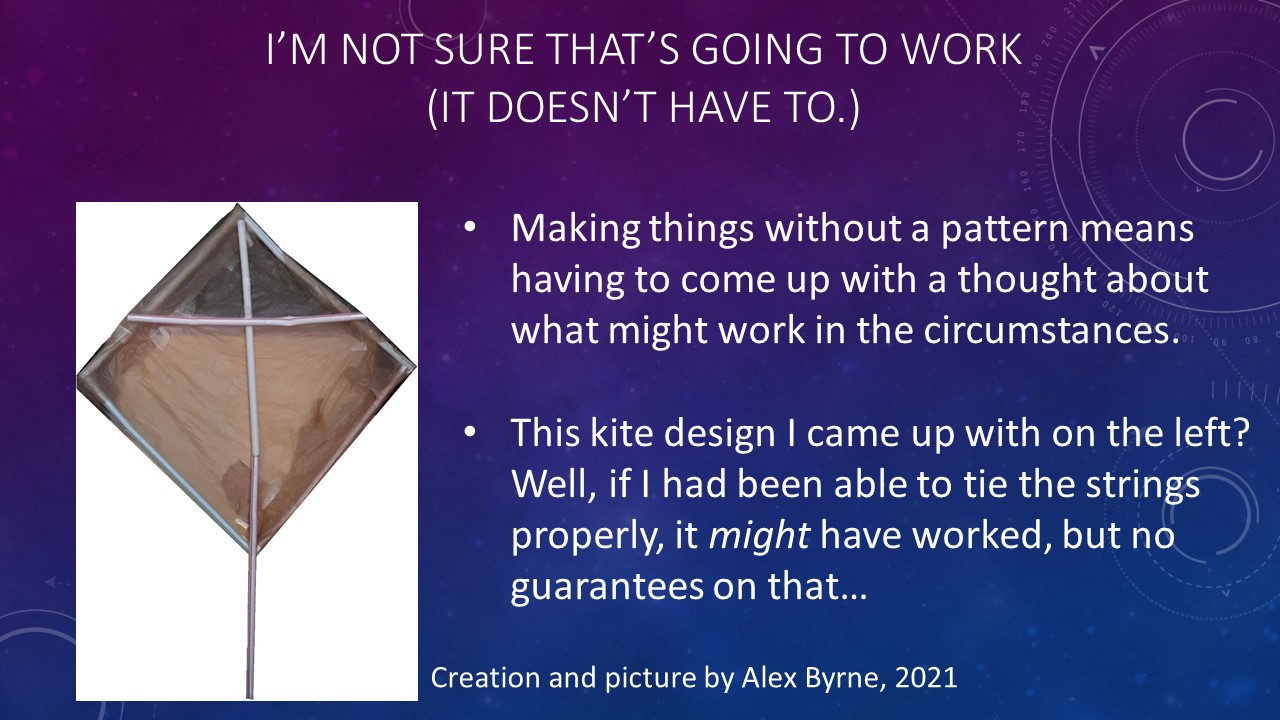
A lot of the time, we were doing the kinds of programming that was "here's the materials, here's the goal, see what you can come up with" using household objects and trying to make a kite, or a parachute, or a wrecking ball. I did a little research on how to make some of those things, with the idea in mind that I could help someone with some hints, but for the most part, I was working right alongside the children in trying to figure out how something worked or might be put together. And I failed at it and had to iterate on it and keep trying until I found something that worked just as much as the children did.
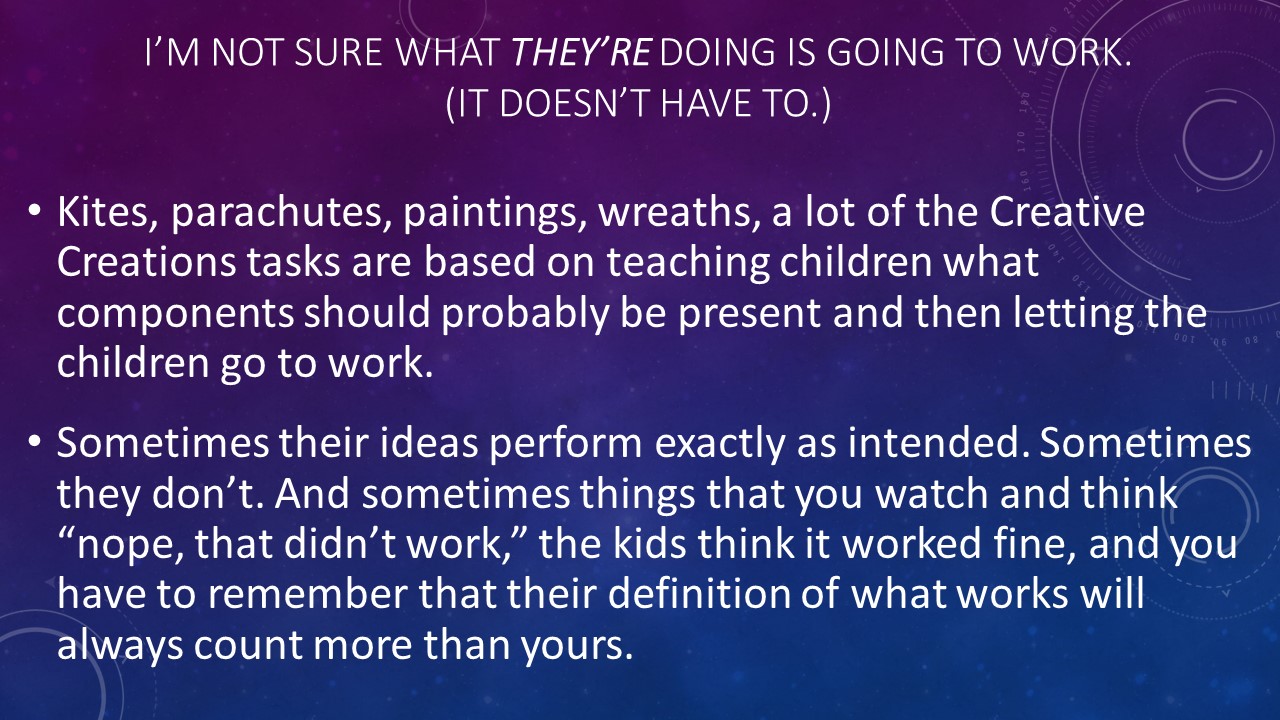
The other thing I had to keep in mind was that my definition of success and their definition of success could sometimes be wildly different from each other. What I thought of as reaching the goal might be a parachute that actually floats for a bit before touching down. For the children, their goal might be that the parachute opens and flares, even if it doesn't slow the object's descent for more than a few fractions of a second. Their goal might have been to make something that looks neat that they can fling from the top of the stairs and delight in that, while I'm trying to figure out how big a parachute I would actually need to slow something down of any appreciable mass. I had to learn that whatever I thought the goal was for the program was mostly irrelevant compared to what the children thought of as their goals. And that their idea of success was the more important one to celebrate. (In theory, I knew this, but I had to practice it a lot, especially when I was felling like I hadn't accomplished anything in the time.
Doing these programs, this way, ultimately helped me come to a better understanding of myself and my capacity for programming. And that I could venture outside of the more restricted programming I had been doing and put on things with open-ended goals and without clearly defined methods to get there. And that even things that looked ugly often tasted delicious. By working with these kids in an environment that was free of a lot of the pressures of having to be the adult, or having to be the expert, or otherwise being responsible for ensuring that everything went smoothly and according to plan, I found that I could be okay with the messiness of it all and the possibilities of failure and being able to let myself breathe about my skills and not having to constantly compare myself to the people who were the absolute best at that thing.